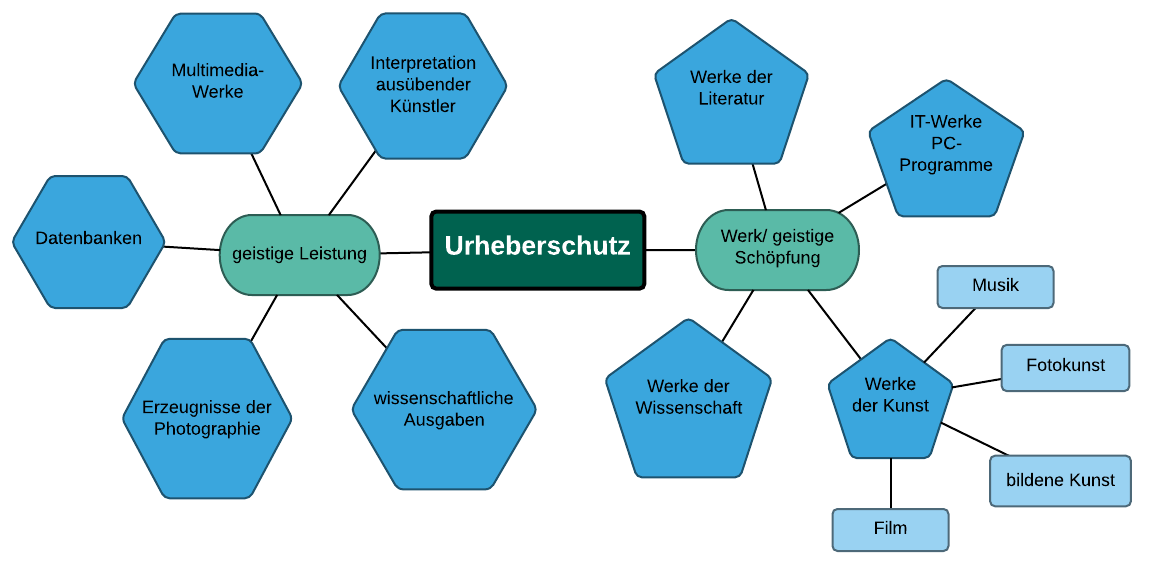Entscheidungshilfe Daten veröffentlichen
Rechtsnormen und Gesetze, insbesondere Datenschutz und Urheberrecht, sorgen bei Forschenden oftmals…

Von Schöpfenden und Schröpfenden und denen, die es gerne wären
Rechtliche Rahmenbedingungen müssen nicht nur während eines Forschungsvorhabens, sondern in besonderer Weise bei dessen Nachnutzung berücksichtigt werden. Der Schutz des Urheberrechts und der berechtigten Interessen Dritter müssen gewährleistet sein, selbst wenn die Verantwortlichkeit für einen Datensatz unklar oder die oder der Verantwortliche nicht greifbar sein sollte. Deshalb sollten bei der Planung eines Forschungsvorhabens grundlegende rechtliche Fragen im Voraus abgeklärt werden.
Die herrschende juristische Meinung geht davon aus, dass einzelne Forschungsdaten nur selten dem Urheberrecht unterliegen. Das heißt aber nicht, dass sie nicht auch auf andere Weise (z. B. als Betriebsgeheimnis oder Vermögensgegenstand) schutzwürdig sein können.. Wir empfehlen Einrichtungen und Forscherinnen und Forschern Forschungsdaten trotzdem zunächst so zu behandeln, als wären sie regelmäßig schutzwürdig nach dem Urheberrecht, um durch einfache Maßnahmen (z. B. Namensnennung, Einbindung der Urheberin oder des Urhebers in Publikationsentscheidungen) etwaige Probleme zu vermeiden, die bei der Verarbeitung und Organisation vieler solcher Daten anfallen. So besteht auch im Einzelfall größtmögliche Rechtssicherheit.
Das Urheberrecht (UrhG) schützt bestimmte geistige Schöpfungen und Leistungen (siehe Abb. 1). Dabei liegt der Schutzfokus bei der Geistesschöpfung auf dem entstandenen Werk insgesamt und bei den geistigen Leistungen auf dem Leistungsprozess. Eine Datenbank ist ein gutes Beispiel: werden viele Werke zusammengefasst, liegt oft keine Neuschöpfung vor (mangelnde Schöpfungshöhe). Es besteht kein neues Schutzrecht auf eines der Werke, aber womöglich auf die Leistung der Zusammenstellung.

Grundsätzlich müssen bei wissenschaftlicher Forschung die Rechte an geistigem Eigentum berücksichtigt werden. Ist ein Werk urheberrechtlich geschützt, ist die Einwilligung des Urhebers zu dessen Vervielfältigung oder Weiterverbreitung unabdingbar. Prinzipiell können Forschungsdaten in Deutschland dem Urheberrecht unterliegen. Dies trifft jedoch bspw. auf unstrukturierte Messdaten nicht zu. Werke sind erst als „persönliche geistige Schöpfungen“ definiert (§ 2 Abs. 2 UrhG), wenn sie die folgenden vier Eigenschaften aufweisen (s. Aufklapptabelle): wahrnehmbare Formgestaltung, persönliches Schaffen, geistiger Gehalt und ein bestimmtes Maß eigenpersönlicher Prägung.[1]
| Wahrnehmbare Formgestalt | Das Kriterium der wahrnehmbaren Formgestaltung schließt bloße Ideen aus, die sich nicht in wahrnehmbarer Form manifestiert haben. Mittelbare Wahrnehmbarkeit (über technische Hilfsmittel) reicht aber aus. |
| Persönliches Schaffen | Ein Handlungsergebnis, das durch den gestaltenden, formprägenden Einfluss eines Menschen geschaffen wurde. Von Maschinen und Tieren geschaffene Dinge scheiden aus. |
| Geistiger Gehalt | Der Urheber muss eine Gedanken- und/oder Gefühlswelt erzeugen, die in irgendeiner Weise anregend auf den Betrachter wirkt. Der "Sinn" muss sich nicht jedem erschließen, aber eine lange Anleitung darf nicht vorausgesetzt werden. |
| Eigenpersönliche Prägung | Ein gewisses Maß an Individualität und Originalität muss erreicht sein. Das erforderliche Maß nennt man Schöpfungshöhe. Eingesetzter Fleiß, Expertise oder handwerkliches Geschick sind kein Kriterium. |
Vor allem an dem 4. Maß, der Schöpfungshöhe scheitert der urheberrechtliche Schutzanspruch von Forschungsdaten regelmäßig. Plakativ gesprochen muss ein Teil des Schaffenden oder die geistige intellektuelle Höhe im Werk erkennbar sein. In maschinell erzeugten Forschungsdaten ist die Schöfpungshöhe nicht erkennbar, möglicherweise sind aber die weiterverarbeiteten Daten - je nach Aggregationsstufe und der damit verbundenen geistigen Leistung - doch schutzwürdig. Allerdings zeichnen sich Forschungsdaten ja gerade dadurch aus, dass sie nicht vom Individuum des Forschenden abhängen sollen.
Werden Forschungsdaten in einer Datenbank gesammelt, kann dies einen eigenen Urheberschutz begründen und sollte daher von Projektseite mitbedacht werden (§4 UrhG).[2] Datenbanken unterliegen nach deutschem Recht einem spezifischen Schutz, der den Erstellern der Datenbank das alleinige Recht zu ihrer Verbreitung und Vervielfältigung gewährt (§ 87b UrhG).
Lediglich die Verwendung eines unwesentlichen Teils der Datenbank (15% oder weniger) ist ohne Zustimmung des Datenbankerstellers erlaubt; für die Vervielfältigung eines wesentlichen Teils einer Datenbank ist eine Einwilligung außerdem dann nicht erforderlich, wenn diese Vervielfältigung zum privaten Gebrauch oder zur Veranschaulichung im Unterricht erfolgt (§87c UrhG). Darüber hinaus sind Kopien – sowohl von Datenbanken als auch allgemein von urheberrechtlich geschützten Werken – zum „persönlichen wissenschaftlichen Gebrauch“* zulässig, wenn die Vervielfältigung zu diesem Zweck „geboten“** ist und keinen gewerblichen Zwecken dient (§ 44a-§ 63 UrhG).
In Zweifelsfällen sollte eine Klärung mit den Rechteinhabern angestrebt werden, die gegebenenfalls in Form eines rechtsverbindlichen Vertrages münden sollte. Nicht nur für den rechtlichen Schutz der verwendeten fremden Daten sollten Überlegungen angestellt werden, sondern auch bezüglich der Rechte an den im Rahmen des Projektes erstellten eigenen Daten sowie der Kontrolle der Einhaltung dieser Rechte.
Durch das Anwenden von Lizenzen können auf einfachem Weg Restriktionen festgelegt werden (z. B. GPL, BSD oder Creative Commons). Dennoch muss bei bestimmten Daten überprüft werden, ob nicht das Patentrecht greift. Im Zweifel sollte ein Patentanwalt konsultiert werden. Demnach darf allein der Patentinhaber die patentierte Erfindung benutzen - allen anderen ist es verboten (§ 9 PatG). Für den wissenschaftlichen Bereich gibt es aber Ausnahmen. Hier kommt insbesondere das Forschungs- bzw. Versuchsprivileg *** (§ 11 Abs. 2 PatG) zum Tragen.
– Veröffentlichungsrecht (§ 12 UrhG)
– Recht der körperlichen Verwertung (§ 15 UrhG)
– Vervielfältigungsrecht (§§ 16; 69c Nr. 1 UrhG)
– Verbreitungsrecht (§§ 17; 69c Nr. 3 UrhG)
– Vortrags- und Aufführungsrecht (§ 19 UrhG) u. v. m.
– Vervielfältigung für den eigenen, privaten Gebrauch (§ 53 Abs. 1 UrhG)
– Zitatrecht zugunsten der Allgemeinheit (§ 51 UrhG)
– Benutzung eines Datenbankwerkes (§ 55 a UrhG)
– Öffentliche Reden (§ 52 UrhG)
Das Urheberrecht kommt erst zum Tragen, wenn die geistige Schöpfung oder Leistung verwirklicht wurde, also eine "wahrnehmbare Formgestalt" angenommen hat. Das Werk wird von diesem Schöpfungsbeginn an unter dem Namen des Urhebers geschützt (bis zum Beweis des Gegenteils; nach § 10 UrhG). Die allgemeine Schutzfrist beträgt 70 Jahre (§ 64 UrhG) und wird grundsätzlich vom Tod des Urhebers an gerechnet. Nach Ablauf der Schutzfrist sind die Werke „gemeinfrei" und dürfen ohne Genehmigung des ursprünglichen Urhebers genutzt (d. h. bearbeitet, vervielfältigt oder vorgeführt) werden.[2]
Die beiden effektivsten Möglichkeiten an Berechtigungen für eine potenzielle Nachnutzung zur Übertragung von Daten sind Lizenzen und Verzichte.
Eine Lizenz ist in diesem Zusammenhang ein Rechtsinstrument, mit dem der Rechteinhaber einer zweiten Partei erlauben kann, Dinge zu tun, die sonst gegen gehaltenes Recht verstoßen würden. Erstens muss beachtet werden, dass nur die Rechteinhaber (oder jemand mit einem Recht oder einer Lizenz in ihrem Namen zu handeln), eine Lizenz erteilen können. Es ist daher unerlässlich, dass die Rechte des geistigen Eigentums („Intellectual Property Right“) der Daten zuerst etabliert werden müssen, bevor eine Lizenzierung stattfinden kann. Somit hat z. B. „die Lizenznutzung der Initiative Creative Commons (CC) bei der offenen Zugänglichmachung von Forschungsdaten nur dann eine differenzierte urheberrechtliche Wirkung, wie sich die Lizenz auf schöpferische Teile der Forschungsdaten bezieht.“ Schöpferische Teile der Forschungsdaten sind bspw. Ausarbeitungen, Papers und nicht voll automatisierte Diagramme und Darstellungen.
Messdaten sind aus urheberrechtlicher Sicht nicht schutzfähig. Schutzfähig können jedoch Datenbanken sein, in welchen die Daten gespeichert werden. Bedingt ist dies durch das Leistungsschutzrecht des Datenbankherstellers. Dieses beruht auf der europäischen Datenbankrichtlinie 96/9/EG und schützt allein die Investition des Datenbankherstellers.[5] Zweitens werden einige Lizenzen im Rahmen von Verträgen unterbreitet. Solche Verträge können sowohl dem Lizenznehmer als auch dem Lizenzgeber zusätzliche Beschränkungen auferlegen.
Ein Verzicht auf Rechte dagegen ist ein Rechtsinstrument, mit dem die eigenen Rechte an einer Ressource abgeben werden können, sodass Zuwiderhandlungen nicht zu Problemen führen können. Auch hier kann nur die Rechtspersönlichkeit, die die Rechte (oder jemand mit einem Recht oder einer Lizenz in ihrem Namen zu handeln) hält, einen Verzicht erklären. Beachten Sie, dass ein Verzicht nicht andere Parteien autorisiert Rechte geltend zu machen.[6]
Ein vollständiger Verzicht auf das Urheberrecht, wie oben beschrieben, ist im Hinblick auf das Urheberpersönlichkeitsrecht im deutschen Rechtsraum nicht möglich (§ 29 UrhG). Daher behält z. B. auch ein Angestellter das Urheberrecht an seinen Arbeiten, welche im Rahmen eines Dienstverhältnisses geschaffen werden, auch wenn die zugehörigen Nutzungsrechte vollständig an den Arbeitgeber übertragen worden sind.[3]
Ein ausschließlicher Verwertungsanspruch der Forschungseinrichtung kann aber bestehen, wenn die Daten als Betriebsgeheimnis angesehen werden. Es ist Aufgabe der Einrichtungen entsprechende Festlegungen zum Umgang mit Forschungsdaten zu treffen.
Erlangt ein Arbeitnehmer Nutzungsrechte im Rahmen einer Angestelltentätigkeit, stehen diese dem Arbeitgeber zu. Dabei erfolgt die Einräumung der Nutzungsrechte regelmäßig im Voraus bei Abschluss des Arbeits- oder Dienstvertrages, spätestens jedoch mit Ablieferung des Werkes (§ 43 UrhG). Vorausgesetzt der/die Urheber/in eines Werkes bzw. der/die Datenbankersteller/in oder Lichtbildner/in stand in einem Angestellten- oder Dienstverhältnis zur Universität, wäre der/die Arbeitnehmer/in also gegenüber der Universität grundsätzlich zur Übertragung der Nutzungsrechte verpflichtet. Zu beachten ist allerdings, dass aufgrund der durch Art. 5 Abs. 3 GG verfassungsrechtlich garantierten Wissenschaftsfreiheit diese Grundsätze nicht auf Hochschul-, Honorar- oder Gastprofessoren/innen übertragen werden können, da die Veröffentlichung von Forschungsergebnissen nicht mehr zu deren Aufgabenbereich gehört. Handelt es sich bei dem/der Urheber/in oder Ersteller/in des Datenbankwerkes um eine/n Professor/in, wird die Universität daher nicht aufgrund des bestehenden Arbeitsverhältnisses Inhaberin der entsprechenden Nutzungsrechte.
Wichtig bei Arbeitsverträgen ist:
Urheberschaft und weitere Rechte, die sich auf Forschungsdaten beziehen, müssen geklärt sein, bevor die Projektphase einsetzt. Daten mit mehreren Urhebern können nicht mit Dritten geteilt werden bis eine Erlaubnis von allen Urhebern vorliegt. Wurde ein Artikel bei einem Verlag veröffentlicht, kann dieser/jener den freien Zugang zum Artikel einschränken. Dabei hängt die Art der Beschränkung davon ab, was zwischen dem/r Herausgeber/in und dem/r Autor/in vor der Veröffentlichung vereinbart worden ist (vgl. Rights and licensing, University of Oxford).
Der Service SHERPA/RoMEO der Universität Nottingham listet Verlage und deren assoziierte Copyright-Vereinbarungen auf: Mit Hilfe von RoMEO können Verlage, aber auch einzelne Journale, dazu abgefragt werden, welche Copyrights welchen Herausgebern zugeordnet sind und welche Rechte beim Urheber/in verbleiben.
Hierzulande wurde das Urhebergesetz im § 38 UrhG um einen vierten Absatz, das sogenannte Zweitveröffentlichungsrecht (ZVR), ergänzt. „Mit dem ZVR erhalten die Autoren wissenschaftlicher Publikationen, die bestimmte Bedingungen erfüllen, das einfache Nutzungsrecht, ein Jahr nach der Erstveröffentlichung eine elektronische Kopie der Manuskriptversion dieser Publikation öffentlich zugänglich zu machen. Ob eine Autorin oder ein Autor für eine bestimmte Veröffentlichung ein ZVR hat, entscheidet sich nicht in Abhängigkeit eines bestimmten Status, z. B. Staatsangehörigkeit oder Anstellungsverhältnis, von ihm. Entscheidend ist vielmehr, ob die Publikation drei Bedingungen erfüllt“:[4]